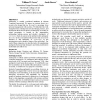Free Online Productivity Tools
i2Speak
i2Symbol
i2OCR
iTex2Img
iWeb2Print
iWeb2Shot
i2Type
iPdf2Split
iPdf2Merge
i2Bopomofo
i2Arabic
i2Style
i2Image
i2PDF
iLatex2Rtf
Sci2ools
CHI
2003
ACM
2003
ACM
Ambiguity as a resource for design
Ambiguity is usually considered anathema in Human Computer Interaction. We argue, in contrast, that it is a resource for design that can be used to encourage close personal engagement with systems. We illustrate this with examples from contemporary arts and design practice, and distinguish three broad classes of ambiguity according to where uncertainty is located in the interpretative relationship linking person and artefact. Ambiguity of information finds its source in the artefact itself, ambiguity of context in the sociocultural discourses that are used to interpret it, and ambiguity of relationship in the interpretative and evaluative stance of the individual. For each of these categories, we describe tactics for emphasising ambiguity that may help designers and other practitioners understand and craft its use. Keywords Interaction design, Emotion and Affective UI, Design, Theory, Design Tips and Tricks, Heuristics, Interpretation
Related Content
| Added | 01 Dec 2009 |
| Updated | 01 Dec 2009 |
| Type | Conference |
| Year | 2003 |
| Where | CHI |
| Authors | William W. Gaver, Jacob Beaver, Steve Benford |
Comments (0)

